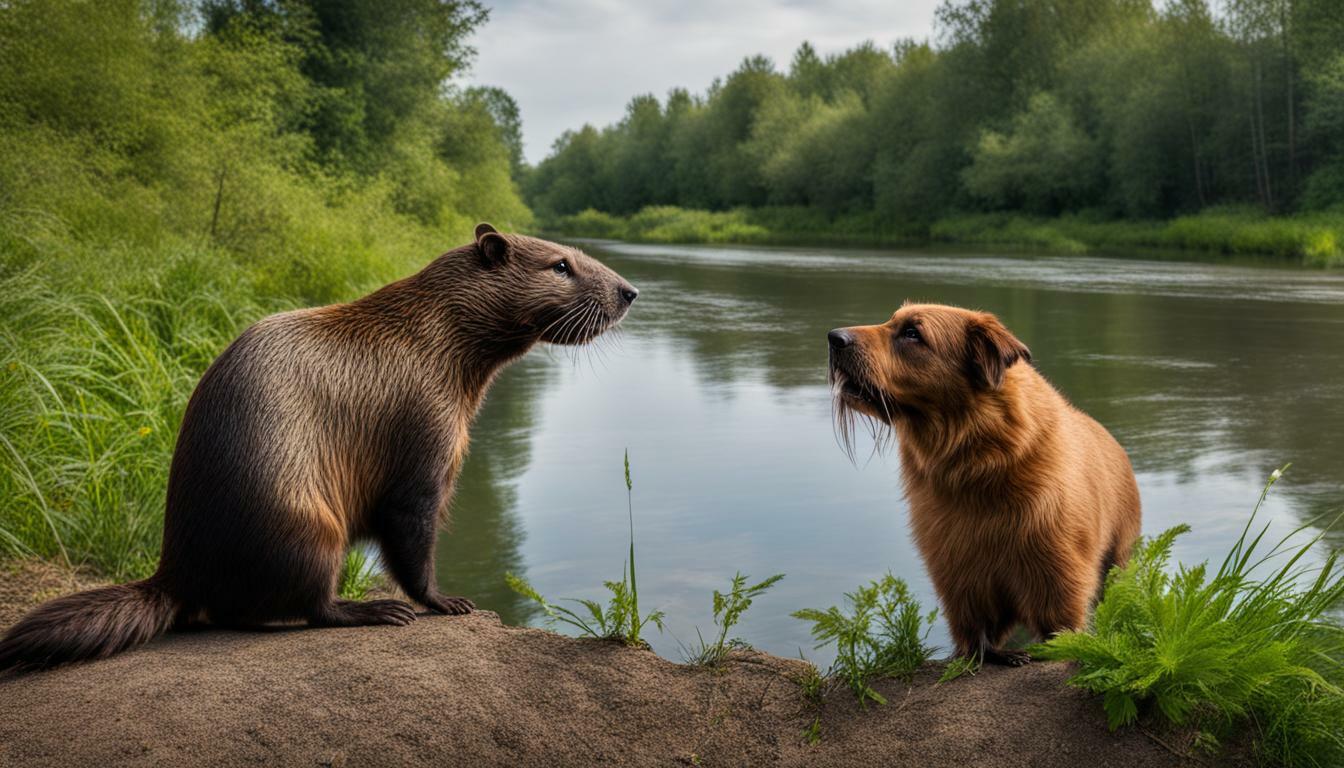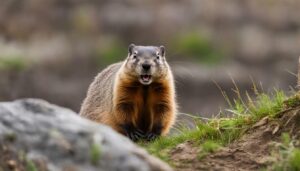If you’re wondering “Do Beavers Attack Dogs?” it’s essential to gather accurate information about these interactions to keep your furry friends safe. Beavers are generally not aggressive towards humans or animals, but there have been instances where beavers have attacked dogs. In one incident in Medford, New Jersey, a beaver attacked a large dog walking with its owner along the Rancocas Creek, biting the dog’s hind leg and dragging it toward the water. The owner was able to intervene and stop the attack. Another incident occurred in Anchorage, Alaska, where a beaver bit a dog multiple times on its rump. Both attacks resulted in injuries to the dogs. These incidents highlight the importance of being cautious when walking dogs near wooded areas and waterways where beavers may be present. It is recommended to keep dogs leashed and exercise caution.
Key Takeaways:
- Beavers are generally not aggressive but have been known to attack dogs in certain situations.
- Instances of beaver attacks on dogs have been reported in Medford, New Jersey, and Anchorage, Alaska.
- When walking dogs near wooded areas or waterways, it’s important to keep them leashed and be cautious.
- Understanding beaver behavior and recognizing signs of aggression can help prevent potential attacks.
- Consulting with local wildlife experts or park authorities can provide additional guidance on dog safety around beavers.
Understanding Beaver Behavior towards Dogs
To assess the risk of beaver attacks on dogs, it’s crucial to understand how beavers typically behave when encountering canines. Beavers are generally not aggressive towards humans or animals, but there have been instances where beavers have attacked dogs. It is important to recognize the signs of beaver aggression to ensure the safety of our furry companions.
When it comes to dogs, beavers may perceive them as potential threats or intruders. Beavers are known to be territorial and protective of their habitats, particularly near wooded areas and waterways. If a beaver feels threatened by a dog, it may exhibit signs of aggression. These signs can include loud tail slapping on the water, hissing or growling noises, and lunging towards the perceived threat.
In some cases, beavers may physically attack a dog by biting or lunging. The recent incidents in Medford, New Jersey, and Anchorage, Alaska, where dogs were injured by beavers, serve as reminders that caution is necessary when walking dogs near beaver habitats. It is important to keep dogs leashed and closely supervised, especially in areas with known beaver activity.
| Signs of Beaver Aggression towards Dogs |
|---|
|
Instances of Beaver Attacks on Dogs
Although rare, there have been instances where beavers have attacked dogs, highlighting the need for caution and preventive measures. These incidents serve as a reminder that even animals known for their peaceful nature can exhibit aggression when provoked or feel threatened.
One notable case occurred in Medford, New Jersey, where a beaver attacked a large dog walking with its owner along the Rancocas Creek. The beaver bit the dog’s hind leg and attempted to drag it toward the water. Fortunately, the owner acted quickly, intervening to stop the attack and prevent further harm to their pet.
Similarly, in Anchorage, Alaska, a dog was bitten multiple times on its rump by a beaver. The incident occurred near a waterway, and the injuries sustained by the dog required medical attention. These incidents highlight the importance of being cautious when walking dogs near wooded areas and waterways where beavers may reside.
To ensure the safety of both dogs and beavers, it is recommended to keep dogs leashed and exercise caution in areas known to have a beaver presence. Maintaining a safe distance and being aware of your surroundings can go a long way in preventing unwanted interactions. If you encounter a beaver, it is advisable to slowly and calmly move away, giving the animal sufficient space.
| Preventive Measures: |
|---|
| Keep dogs leashed when walking in areas with beaver habitats |
| Remain cautious and aware of your surroundings at all times |
| Keep a safe distance from beavers and their habitat |
| If you encounter a beaver, slowly and calmly move away |
The Medford, New Jersey Incident
One incident in Medford, New Jersey, serves as an example of a beaver attack on a dog and illustrates the importance of proactive action to protect your furry companion. In this case, a beaver attacked a large dog while it was walking with its owner along the scenic Rancocas Creek. The beaver targeted the dog’s hind leg and attempted to drag it toward the water.
The owner quickly recognized the danger and intervened, preventing further harm to their beloved pet. Although the dog sustained injuries, this incident highlights the need for dog owners to be cautious and aware of their surroundings when walking near wooded areas and waterways that are home to beavers.
To prevent beaver attacks on dogs, it is essential to take preventive measures. Keeping your dog leashed while exploring areas with beaver habitats can help ensure their safety. Additionally, remaining vigilant for signs of beaver presence, such as visible dams or lodges, and potential signs of aggression, such as teeth gnashing or tail slapping, can provide valuable early warnings to protect your pet.
| Preventing Beaver Attacks on Dogs |
|---|
| Keep your dog leashed when walking near beaver habitats. |
| Be aware of signs of beaver presence, such as dams or lodges, and potential signs of aggression. |
| Intervene promptly if a beaver approaches your dog or shows signs of aggression. |
| Consult with local wildlife experts or park authorities for additional guidance on dog safety around beavers. |
By following these proactive measures, you can help ensure the safety of your furry friend and foster a harmonious coexistence between dogs and beavers in areas where they share habitats.
The Anchorage, Alaska Incident
In Anchorage, Alaska, a beaver attack on a dog resulted in injuries, showcasing the potential risks associated with encounters between canines and beavers. Although beavers are generally not aggressive towards humans or animals, there have been instances where dogs have been targeted by these creatures.
During the incident, a beaver bit the dog multiple times on its rump, causing significant harm. This highlights the importance of being cautious when walking dogs near wooded areas and waterways where beavers may be present. Dogs, especially when unleashed, can unknowingly provoke or startle beavers, leading to defensive reactions.
To prevent such encounters, it is recommended to keep dogs leashed and under control when near beaver habitats. Additionally, maintaining a safe distance from beavers and being observant of their behavior can help avoid potential conflicts. Dogs should be trained to respond to commands, allowing owners to effectively control their pets during outdoor excursions.
| Beaver Behavior Towards Dogs | Preventive Measures |
|---|---|
|
|
Dog-Friendly Areas with Beavers
While beavers may inhabit various areas, there are dog-friendly locations where you can enjoy nature while minimizing the risks associated with beaver interactions.
If you’re looking for dog-friendly areas with beavers, consider exploring state parks that have designated trails and leash policies. These parks often provide a safe environment for dogs to roam while allowing you to appreciate the beauty of beaver habitats. Some popular options include:
- Beaver Creek State Park in Ohio: This serene park offers picturesque hiking trails surrounded by peaceful beaver ponds. Keep your furry friend on a leash and enjoy the sights and sounds of nature.
- Cape Perpetua Scenic Area in Oregon: Known for its stunning coastal views, this area is home to beaver dams and wetlands. Dogs are welcome on the trails as long as they are leashed and under control.
- Wolf Creek Falls Preserve in New York: Take a leisurely stroll through this preserve’s beaver-inhabited wetlands and marvel at the diverse wildlife. Dogs on leashes are permitted, making it a great spot for outdoor enthusiasts.
Remember, even in dog-friendly areas, it’s crucial to prioritize safety. Always keep your dog on a leash and be vigilant for any signs of beaver activity. Beavers are generally peaceful creatures, but if they feel threatened or cornered, they may become defensive. By following these safety tips, you can ensure a pleasant experience for both you and your furry companion.
Table: Dog-Friendly Areas with Beavers
| Location | Description |
|---|---|
| Beaver Creek State Park | Serene Ohio park with beaver ponds and designated trails. |
| Cape Perpetua Scenic Area | Breathtaking Oregon coastal views with beaver habitats. |
| Wolf Creek Falls Preserve | New York preserve featuring beaver-inhabited wetlands. |
Safety Tips for Dogs near Beaver Habitats
To keep your furry friend safe during walks near beaver habitats, it’s essential to follow some simple yet effective safety tips. Beavers are generally not aggressive towards humans or animals, but there have been instances where beavers have attacked dogs. Therefore, it’s important to exercise caution and be aware of your surroundings when in wooded areas or near waterways.
Here are some helpful safety guidelines to follow:
- Keep your dog leashed: Keeping your dog on a leash helps you maintain control and prevents them from getting too close to beaver habitats. This ensures a safe distance between your dog and any potentially territorial beavers.
- Stay vigilant and watch for signs of aggression: Beavers may display warning signs such as tail slapping on the water or vocalizations. If you notice these warning signs, it’s best to move away from the area and avoid any potential conflict.
- Avoid letting your dog swim in beaver ponds: Beavers are protective of their territory, and allowing your dog to swim in their ponds can lead to confrontations. It’s better to find designated dog-friendly areas for swimming that are free from beaver activity.
- Choose alternative routes if necessary: If you encounter beavers or signs of their presence, such as dams or lodges, it’s wise to choose an alternative route for your walk. This minimizes the risk of accidental encounters and potential conflicts.
Remember, the key to ensuring your dog’s safety near beaver habitats is to be proactive and informed. By following these safety measures, you can enjoy your walks with peace of mind, knowing that you’re taking the necessary precautions to protect both your furry friend and the beavers in their natural environment.
| Safety Tips | Summary |
|---|---|
| Keep your dog leashed | Maintains control and distance |
| Stay vigilant | Watch out for warning signs |
| Avoid beaver ponds | Prevent territorial conflicts |
| Choose alternative routes | Minimize risk of encounters |
Keeping Dogs Leashed
One fundamental rule for ensuring dog safety near beavers is to always have your furry companion on a leash, providing better control and minimizing potential risks. By keeping your dog leashed, you can prevent them from approaching beavers too closely, reducing the likelihood of conflicts or aggressive encounters. Remember that beavers are wild animals, and even though they are generally not aggressive towards humans or dogs, it is always best to exercise caution.
Table: Benefits of Keeping Dogs Leashed
| Benefits | Explanation |
|---|---|
| Prevent Unwanted Interactions | Leashing your dog ensures they do not approach beavers, reducing the risk of an unexpected interaction. |
| Increased Safety | Having your dog on a leash provides you with control, allowing you to react quickly if you encounter a beaver or any other potentially dangerous situation. |
| Respect Wildlife | By keeping your dog leashed, you respect the natural habitat of beavers and other wildlife, promoting a harmonious coexistence. |
In addition to keeping your dog leashed, it is essential to be mindful of your surroundings when walking near beaver habitats. Be observant for any signs of beaver activity, such as freshly chewed trees, dams, or lodges. These signs indicate that beavers are present, and you should maintain a safe distance to avoid any potential conflicts. Remember, prevention is key to ensuring the safety of both your dog and the beavers.
Tip: If you are unsure about the safety of a particular area, consult with local wildlife experts or park authorities. They can provide you with valuable guidance on dog safety around beavers and advise on dog-friendly areas that minimize the risk of encountering beavers. Remember, it’s better to be safe than sorry when it comes to the well-being of your furry friend.
Exercising Caution and Awareness
It’s crucial to exercise caution and remain aware of your surroundings when venturing near beaver habitats, keeping your dog safe from potential confrontations. While beavers are generally not aggressive towards humans or animals, there have been instances where beavers have attacked dogs, resulting in injuries. To prevent such incidents, here are some essential safety tips to follow:
- Keep your dog on a leash: By keeping your dog leashed, you have better control over their movements and can prevent them from approaching beaver habitats.
- Stay vigilant: Pay attention to any signs of beaver activity, such as chewing marks on trees, dam constructions, or the presence of lodge entrances. Avoid areas where these signs are prevalent.
- Give beavers their space: Beavers are territorial creatures, and getting too close to their habitat may provoke defensive behavior. Maintain a respectful distance to reduce the risk of any unwanted interactions.
- Avoid walking at dusk or dawn: Beavers are primarily nocturnal, so it’s advisable to avoid walking your dog near beaver habitats during the early morning or late evening when their activity is at its peak.
| Safety Tip | Description |
|---|---|
| Refrain from letting your dog swim in beaver ponds | Beaver ponds are their territorial territories. Allowing your dog to swim in these areas may trigger defensive responses from beavers. |
| Teach your dog “leave it” command | Training your dog to respond to the “leave it” command can be helpful in redirecting their attention away from beavers or other potential hazards. |
| Consult local wildlife experts | Reach out to local wildlife experts or park authorities for specific guidance on dog safety around beavers in your area. They can provide additional insights and recommendations based on local conditions. |
By following these precautions, you can enjoy peaceful walks with your dog while respecting the presence of beavers in their natural habitat. Remember, the key is to prioritize the safety of both your dog and the beavers when coexisting in shared spaces.
Seeking Professional Guidance
If you have concerns about dog safety or want more specific advice on how to prevent beaver attacks, consider reaching out to local wildlife experts or park authorities. These professionals have the knowledge and experience to provide valuable insights on how to keep your dog safe in areas where beavers may be present.
When contacting wildlife experts or park authorities, be prepared to provide details about the location where you encountered the beaver or where you plan to walk your dog. This information will help them assess the potential risk and offer tailored recommendations to ensure both your dog’s safety and the preservation of the beaver’s natural habitat.
Additionally, these experts can share tips on identifying signs of beaver presence, such as dam-building activities or gnawed trees. Being able to recognize these signs will allow you to take appropriate precautions and modify your walking route if necessary.
Benefits of Seeking Professional Guidance
- Expert knowledge: Wildlife experts and park authorities possess in-depth knowledge about beaver behavior and can provide accurate information to help you understand the dynamics between beavers and dogs.
- Customized advice: By consulting with professionals, you can receive personalized recommendations based on the specific circumstances in your area, ensuring the safety of your dog and the beaver’s welfare.
- Promoting coexistence: Seeking guidance from experts promotes coexistence between dogs and beavers, allowing both species to share and enjoy natural environments harmoniously.
Remember, prevention is key when it comes to ensuring your dog’s safety around beavers. By seeking professional guidance, you gain the necessary knowledge and support to navigate these situations confidently and responsibly.
| Key Points | Actions |
|---|---|
| Reach out to local wildlife experts or park authorities | Contacting professionals who specialize in beaver behavior and dog safety can provide tailored advice based on your specific location. |
| Share details about the encounter or walking route | Providing specific information about your interaction with beavers or walking areas will help experts assess the situation accurately. |
| Learn to recognize signs of beaver presence | Experts can teach you how to identify signs such as dam-building activities and gnawed trees, allowing you to adjust your route if necessary. |
Conclusion
By being aware of how beavers typically behave and following safety guidelines, you can ensure the safety of your dog and foster positive interactions between beavers and canines.
While beavers are generally not aggressive towards humans or animals, there have been instances where beavers have attacked dogs. Two notable incidents occurred in Medford, New Jersey, and Anchorage, Alaska, where dogs were bitten by beavers.
The Medford incident involved a large dog walking with its owner along the Rancocas Creek when a beaver attacked, biting the dog’s hind leg and attempting to drag it toward the water. Fortunately, the owner was able to intervene and stop the attack. In Anchorage, Alaska, a beaver bit a dog multiple times on its rump, resulting in injuries.
These incidents serve as a reminder to exercise caution when walking dogs near wooded areas and waterways where beavers may be present. Keeping your dog leashed is highly recommended, as it allows you to maintain control and avoid unexpected interactions with beavers. Additionally, being vigilant and aware of your surroundings can help you identify signs of beaver aggression and take necessary precautions to keep your dog safe.
FAQ
Do beavers attack dogs?
Beavers are generally not aggressive towards humans or animals, but there have been instances where beavers have attacked dogs.
What are some instances of beaver attacks on dogs?
In Medford, New Jersey, a beaver attacked a large dog walking with its owner along the Rancocas Creek, biting the dog’s hind leg and dragging it toward the water. Another incident occurred in Anchorage, Alaska, where a beaver bit a dog multiple times on its rump.
How can dog owners prevent beaver attacks?
Dog owners should exercise caution when walking dogs near wooded areas and waterways where beavers may be present. It is recommended to keep dogs leashed and be alert to potential signs of beaver aggression.
Are there dog-friendly areas with beavers?
Yes, there are dog-friendly areas where beavers may reside. However, it is important to follow safety tips and guidelines to ensure a pleasant experience for both dogs and their owners.
What are some safety tips for dogs near beaver habitats?
It is crucial to keep dogs leashed when in areas where beavers may be present. Additionally, dog owners should exercise caution and awareness, avoiding unexpected interactions and seeking professional guidance if needed.




